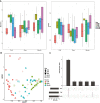Transmission of fungi and protozoa under grazing conditions from lactating yaks to sucking yak calves in early life
- PMID: 37341753
- PMCID: PMC10345012
- DOI: 10.1007/s00253-023-12616-y
Transmission of fungi and protozoa under grazing conditions from lactating yaks to sucking yak calves in early life
Abstract
Microbiota from mothers is an essential source of microbes in early-life rumen microbiota, but the contribution of microbiota from different maternal sites to the rumen microbiota establishment in neonates needs more data. To fill this gap, we collected samples from the mouth, teat skin, and rumen of lactating yaks and from the rumen of sucking calves concomitantly on seven occasions between days 7 and 180 after birth under grazing conditions. We observed that the eukaryotic communities clustered based on sample sites, except for the protozoal community in the teat skin, with negative correlations between fungal and protozoal diversities in the rumen of calves. Furthermore, fungi in the dam's mouth, which is the greatest source of the calf's rumen fungi, accounted for only 0.1%, and the contribution of the dam's rumen to the calf's rumen fungi decreased with age and even disappeared after day 60. In contrast, the average contribution of the dam's rumen protozoa to the calf's rumen protozoa was 3.7%, and the contributions from the dam's teat skin (from 0.7 to 2.7%) and mouth (from 0.4 to 3.3%) increased with age. Thus, the divergence in dam-to-calf transmissibility between fungi and protozoa indicates that the foundation of these eukaryotic communities is shaped by different rules. This study provides the first measurements of the maternal contribution to the fungal and protozoal establishment in the rumen of sucking and grazing yak calves in early life, which could be beneficial for future microbiota manipulation in neonatal ruminants. KEY POINTS: • Dam to calf transfer of rumen eukaryotes occurs from multiple body sites. • A minor proportion of rumen fungi in calves originated from maternal sites. • The inter-generation transmission between rumen fungi and protozoa differs.
Keywords: Dam-to-infant transmission; Eukaryotic microbes; Maternal contribution; Rumen microbial development.
© 2023. The Author(s).
Conflict of interest statement
The authors declare no competing interests.
Figures







Similar articles
-
Maternal rumen and milk microbiota shape the establishment of early-life rumen microbiota in grazing yak calves.J Dairy Sci. 2023 Mar;106(3):2054-2070. doi: 10.3168/jds.2022-22655. Epub 2023 Jan 27. J Dairy Sci. 2023. PMID: 36710176
-
Survey of rumen microbiota of domestic grazing yak during different growth stages revealed novel maturation patterns of four key microbial groups and their dynamic interactions.Anim Microbiome. 2020 Jul 14;2(1):23. doi: 10.1186/s42523-020-00042-8. Anim Microbiome. 2020. PMID: 33499950 Free PMC article.
-
Maternal Fecal Microbes Contribute to Shaping the Early Life Assembly of the Intestinal Microbiota of Co-inhabiting Yak and Cattle Calves.Front Microbiol. 2022 Jun 6;13:916735. doi: 10.3389/fmicb.2022.916735. eCollection 2022. Front Microbiol. 2022. PMID: 35733965 Free PMC article.
-
Role of diverse fermentative factors towards microbial community shift in ruminants.J Appl Microbiol. 2019 Jul;127(1):2-11. doi: 10.1111/jam.14212. Epub 2019 Mar 18. J Appl Microbiol. 2019. PMID: 30694580 Review.
-
Dynamic progression of the calf's microbiome and its influence on host health.Comput Struct Biotechnol J. 2021 Jan 26;19:989-1001. doi: 10.1016/j.csbj.2021.01.035. eCollection 2021. Comput Struct Biotechnol J. 2021. PMID: 33613865 Free PMC article. Review.
Cited by
-
Multi-omics reveals the mechanism of rumen microbiome and its metabolome together with host metabolome participating in the regulation of milk production traits in dairy buffaloes.Front Microbiol. 2024 Mar 8;15:1301292. doi: 10.3389/fmicb.2024.1301292. eCollection 2024. Front Microbiol. 2024. PMID: 38525073 Free PMC article.
References
-
- Allaire J (2012) RStudio: integrated development environment for R. Boston, MA.
-
- Bolyen E, Dillon M, Bokulich N, Abnet C, Al-Ghalith G, Alexander H, Alm E, Arumugam M, Asnicar F, Bai Y, Bisanz J, Bittinger K, Brejnrod A, Brislawn C, Brown T, Callahan B, Chase J, Cope E, Dorrestein P, Douglas G, Durall D, Duvallet C, Edwardson C, Ernst M, Estaki M, Fouquier J, Gauglitz J, Gibson D, Gonzalez A, Gorlick K, Guo J, Hillmann B, Holmes S, Holste H, Huttenhower C, Huttley G, Janssen S, Jarmusch A, Jiang L, Kaehler B, Keefe C, Keim P, Kelley S, Knights D, Koester I, Kosciolek T, Kreps J, Lee J, Ley R, Liu Y-X, Loftfield E, Lozupone C, Maher M, Marotz C, Martin B, McDonald D, McIver L, Melnik A, Metcalf J, Morgan S, Morton J, Navas-Molina J, Orchanian S, Pearson T, Peoples S, Petras D, Pruesse E, Rivers A, Robeson M, Rosenthal P, Segata N, Shaffer M, Shiffer A, Sinha R, Spear J, Swafford A, Thompson L, Torres P, Trinh P, Tripathi A, Turnbaugh P, Ul-Hasan S, Vargas F, Vogtmann E, Walters W, Wan Y, Wang M, Warren J, Weber K, Willis A, Zaneveld J, Zhang Y, Zhu Q, Knight R, Caporaso G. Reproducible, interactive, scalable and extensible microbiome data science using QIIME 2. Nat Biotechnol. 2019;37:852–857. doi: 10.1038/s41587-019-0190-3. - DOI - PMC - PubMed
MeSH terms
LinkOut - more resources
Full Text Sources
Miscellaneous

